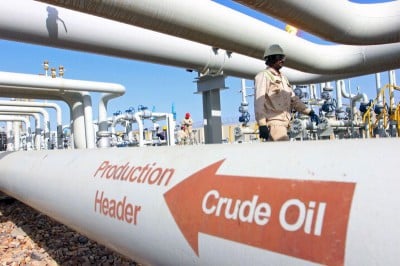 © Reuters. LCO +0.01% Add to/Remove from Watchlist Add to Watchlist Add Position
© Reuters. LCO +0.01% Add to/Remove from Watchlist Add to Watchlist Add Position Position added successfully to:
+ Add another position Close CL +0.14% Add to/Remove from Watchlist Add to Watchlist Add Position
Position added successfully to:
+ Add another position Close DXY -0.09% Add to/Remove from Watchlist Add to Watchlist Add Position
Position added successfully to:
+ Add another position Close
Investing.com-- Oil prices rose in Asian trade on Tuesday as focus remained on a potential escalation in the Israel-Hamas conflict, although disappointing OPEC+ cuts and strength in the dollar kept crude trading near five-month lows.
Fears of a potential escalation in the Israel-Hamas conflict came back into play after the U.S. held Iran responsible for an attack on U.S. vessels in the Red Sea by Houthi forces. But traders remained wary of pricing a risk premium into oil over the conflict, given that it so far had minimal impact on Middle Eastern oil supplies.
Disappointing production cuts from the Organization of Petroleum Exporting Countries and allies (OPEC+) were the key point of contention for oil markets, after the cartel announced new production cuts of less than 1 million barrels per day for early-2024.
Oil bulls were banking on the production cuts to support crude prices, which were battered by persistent concerns that weakening economic activity will dent global crude demand. These concerns remained in play, following a string of weak data points from major economies over the past week.
Brent oil futures expiring February rose 0.1% to $78.14 a barrel, while West Texas Intermediate crude futures rose 0.3% to $73.54 a barrel by 20:31 ET (01:31 GMT). Both contracts were trading just above their weakest levels since early-July, and were nursing six straight weeks of heavy losses.
Also pressuring oil prices was some resilience in the dollar, which rose sharply in overnight trade. Markets were widely awaiting key nonfarm payrolls data, due this Friday, for more cues on the U.S. economy, amid growing optimism that the Federal Reserve was done raising interest rates.
But oil prices had seen little relief from this trade, which had lifted other risk-driven markets over the past month.
OPEC+ cuts disappoint, demand concerns persist
Traders were now growing doubtful over the OPEC+’s ability to reduce production further, given that the new reductions for early-2024 came amid growing discontent among the cartel members over the cuts.
While Saudi Arabia and Russia said they will commit to the voluntary cuts, other producers, such as Angola, rejected the production quotas and said they will increase production in 2024.
“Given the scale of cuts we are already seeing from the group, it is becoming increasingly more difficult for some members to stomach further cuts,” analysts at ING wrote in a note.
ING expects Brent crude to trade in the low-$80s through early-2024, and that the path of crude prices will be largely determined by the OPEC+’s ability to further curb production.
ING analysts also raised concerns over a slowdown in global crude demand, stating that while Chinese demand will remain strong, Europe and the Americas are expected to see a small decline in demand as economic conditions worsen.
Oil prices inch up from near 5-mth lows as Middle East risks persist








